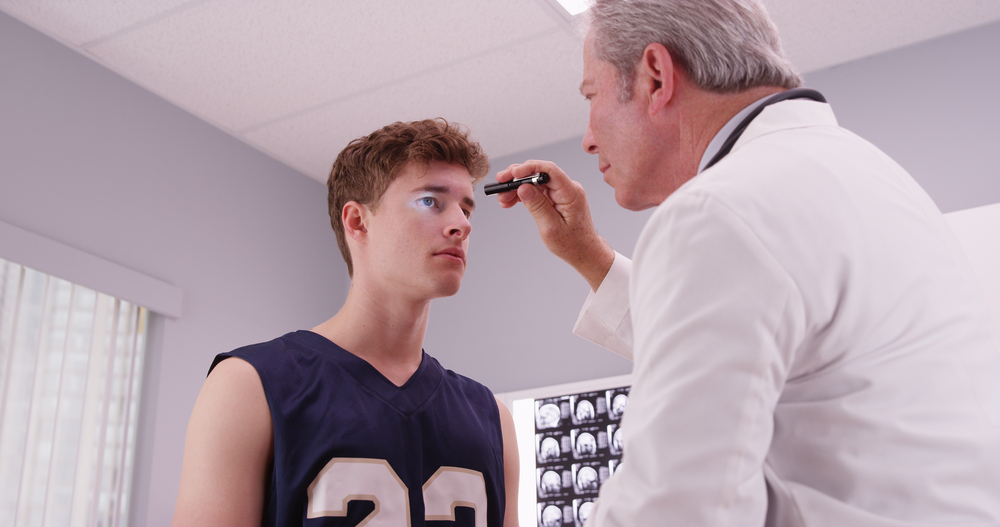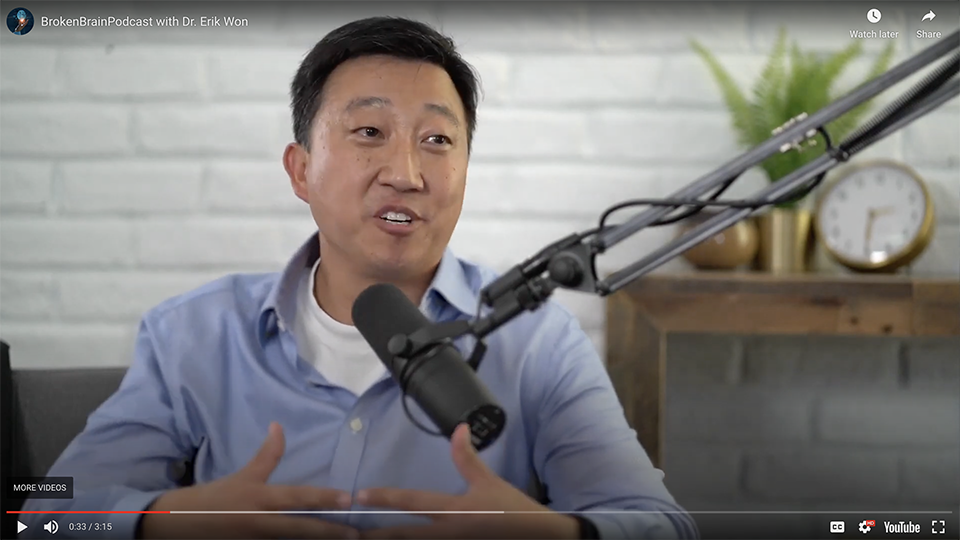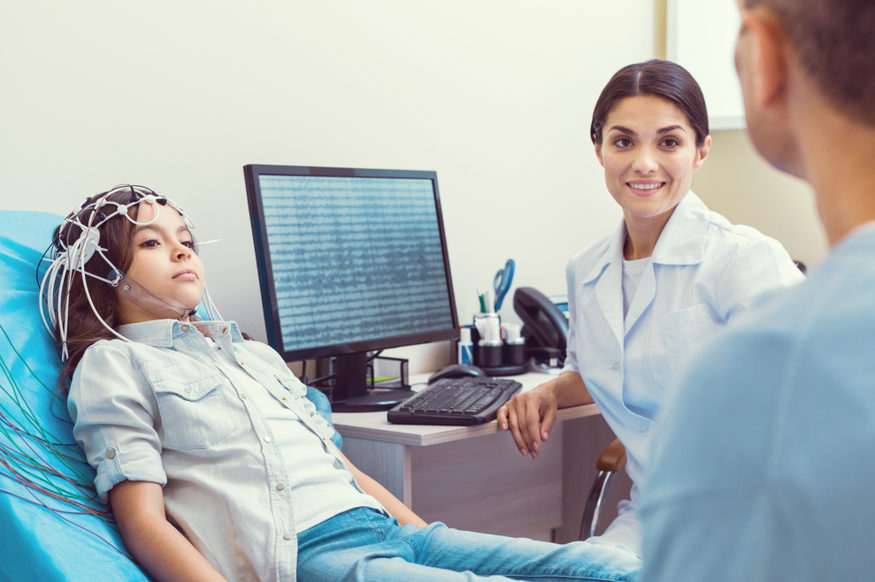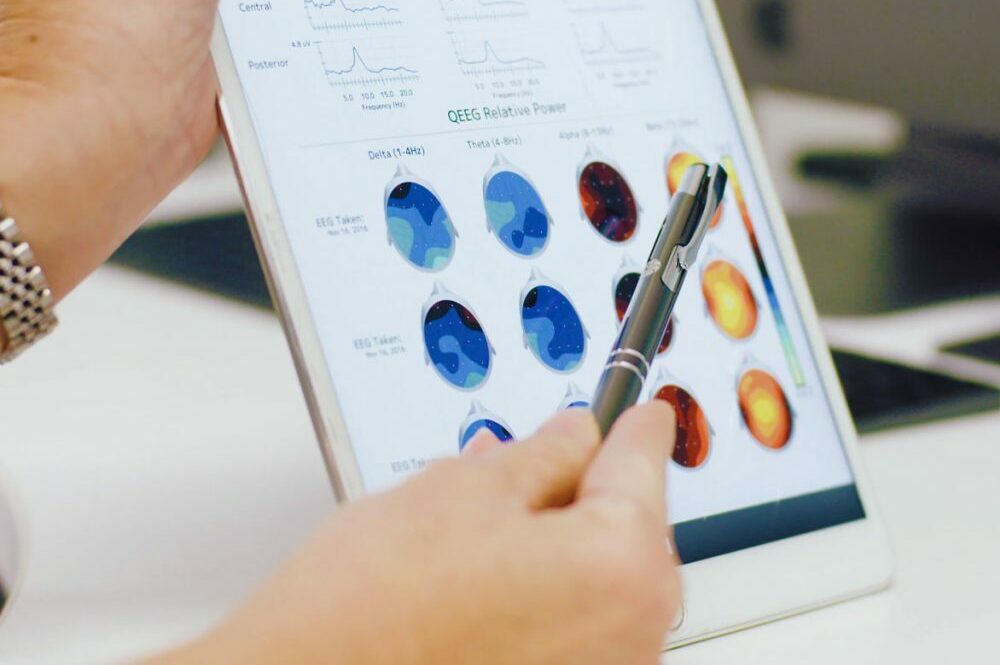
Traumatic Brain Injury
And More Serious Concussions
A New Approach to Treatment of Traumatic Brain Injury and More Serious Concussions
A non-invasive, drug-free treatment to treat the after-effects of a Traumatic Brain Injury or concussion is now available in Dallas, Texas. Neurologist Dr. Spencer Miller has brought this incredible technology to Dallas. It’s called MeRT®, which stands for Magnetic e-Resonance Therapy. Simply stated, we use a magnetic field to stimulate and balance brain function, guided by very sophisticated imaging and diagnostics.
Neurologist Dr. Spencer O. Miller uses MeRT treatment to address traumatic brain injury and serious concussions. If your concussion is not healing or you have had a Traumatic Brain Injury, you might benefit from this treatment.
The CDC (Centers for Disease Control) defines a traumatic brain injury (TBI) as a blow to the head or a penetrating head injury that disrupts the normal function of the brain. TBI can result when the head suddenly and violently hits an object or when an object pierces the skull and enters brain tissue. An injury can also occur without a direct blow to the head, such as in an auto accident where the forces cause the head to move violently in one direction and then snap back in another direction. This causes the brain to be jostled around inside the skull and can also injure the brain.
MeRT Treatment for Traumatic Brain Injury
Here at the Brain Treatment Center Dallas, Dr. Miller and his staff offer MeRT treatment protocols for traumatic brain injuries. MeRT is a unique and improved version of TMS (Transcranial Magnetic Stimulation). This treatment is a much more individualized approach to brain modulation tailored to the patient’s needs based on frequency, location, and power used. TMS modulates the brain’s electrical activity by using magnetic fields that pass through the scalp from an electromagnetic coil, however, it is important to note that TMS is a generalized approach to neuromodulation because it can only target a single location in the brain with a single frequency. We perform a quantitative EEG before treatment so that we can get a precise look at YOUR brain to customize a treatment protocol specifically for you.
While the neuromodulation equipment used in TMS has been cleared by the FDA to treat depression that has been resistant to medications, it may also be used off-label for other disorders in the practice of medicine. These include traumatic brain injury and other brain disorders.
Once we complete treatment, there is not usually a need for any follow-up treatment for traumatic brain injury.
*patient results can vary
How MeRT Differs from Standard TMS
MeRT stands for Magnetic e-Resonance Therapy. MeRTis a cutting-edge treatment protocol that combines technologies of Transcranial Magnetic Stimulation, Quantitative Electroencephalogram (qEEG), and Electrocardiogram (ECG/EKG) to analyze and formulate treatments that are tailored for each individual’s unique brain pattern.
Most TMS treatments are used to deliver stimulation to one area of the brain at a fixed frequency for all patients, however, MeRTis more evolved. This customized, scientific approach is unique to each patient.
We analyze each patient’s initial tests very carefully as to the brain’s pattern of function and activity. Through this detailed analysis, we can determine the correct neural synchronization. This information is then used to devise a highly personalized protocol for each patient, with the purpose of encouraging improved brain communication. Patients have reported feeling significant clinical improvements after going through treatment.*
Treatment for TBI usually lasts 4-6 weeks. Appointments are 30-45 minutes in length, Monday through Friday. Generally, the patient will begin to notice improvements during the first week.
The TMS equipment used is FDA-cleared to treat Major Depressive Disorder and OCD and is used off-label to treat other neurological-related conditions, including Traumatic Brain Injuries.
“The brain has an intrinsic frequency and… it’s different for everybody.”
And if you can align all of the brain tissue to operate under that same frequency, that’s called synchrony coherence efficiency. …
“We [can] see on an EEG… that there is an abnormal signal somewhere in the brain — or a low frequency or discrepancy or asynchrony in frequencies — parts of the brain are not aligned. And we can use electromagnetic energy. It’s like an MRI, except we’re actually transmitting the force back into the brain, and we align with a purer, stronger electrical signal. …
“We’re really seeking to balance the function of the brain.”
Dr. Spencer O. Miller, Neurologist, Owner and Medical Director of Brain Treatment Center Dallas
Spencer O. Miller, M.D. is a Board-Certified Neurologist in Dallas, Texas. He received his medical degree from the University of Mississippi School of Medicine and has been in practice for 13 years, five of which were in the USAF. He saw all types of brain injuries, including soldiers suffering from PTSD and TBI. Dr. Miller specializes in the treatment of ADHD, sleep disorders, traumatic brain injury, depression, post-traumatic stress disorder, dementia, autism, and multiple other brain disorders at his clinic, the Brain Treatment Center Dallas.
Contact our New Patient Coordinator
for more information. Or fill out the form below.
MeRT Treatment for TBI
Hear it for yourself
MeRT has shown tremendous results in improving the lives of those suffering from TBI, like Nick. Listen to his incredible experience with MeRT Treatment for his TBI.
For patients who have a moderate head injury, approximately 60% will make a positive recovery, and about 25% will have moderately impaired function. The ones with severe injuries have moderate-to-severe disabilities.
Athletes are particularly prone to traumatic brain injuries. Elderly people are at higher risk for TBI because as they age, they become more prone to falls.
Children and teens are also at higher risk because they are more active in sports and other physical activities.
Contact our New Patient Coordinator
for more information. Or fill out the form below.
Symptoms of Traumatic Brain Injury (TBI)
Symptoms can range from mild to severe. Milder cases can cause a brief alteration in a person’s mental state. It is entirely possible for a person to have a TBI and not experience a loss of consciousness, though in more severe cases, loss of consciousness usually occurs. Severe cases of TBI can result in long periods of unconsciousness or coma, or death.
People with severe TBI have to be hospitalized, sometimes long-term. They may need rehabilitation for memory, learning, coordination, speech, and other senses, and even for emotions. The injury can affect all aspects of a person’s life, including their relationships, their ability to work again, or the ability to complete day-to-day activities.
Symptoms of a traumatic brain injury vary based on severity but can include:
- Confusion.
- Loss of consciousness.
- Headache.
- Lethargy.
- Dilated pupils.
- Vision changes.
- Memory loss.
- Dizziness.
- Cognitive difficulties.
- Emotional responses that aren’t appropriate.
- Facial weakness or weakness in other parts of the body.
- Loss of control of bowel and/or bladder.
- Breathing problems.
- Numbness or tingling in any part of the body.
- Changes in hearing or ringing in ears.
- Anxiety and/or depression.
MeRT for head injuries is supported by extensive, independently conducted research published over many years
This treatment is a tailored adaptation of rTMS (repetitive Transcranial Magnetic Stimulation) and is founded on a solid base of scientific studies featured in leading academic journals. Here are a few key examples.
The use of repetitive transcranial magnetic stimulation (rTMS) following traumatic brain injury (TBI): A scoping review:
“Evidence suggests that rTMS has the potential to be an efficacious therapeutic intervention for multiple symptoms after TBI, including depression, dizziness, central pain, and visual neglect. “
Neuromodulatory Interventions for Traumatic Brain Injury:
In this special issue of the Journal of Head Trauma Rehabilitation, we share with readers some of the latest advancements in neuromodulation specific to TBI, while providing the framework to further our understanding of how and why functional skills are likely improved. While neuromodulatory interventions can play a critical role in functional recovery for those with TBI, the heterogenous nature of TBI means that clinical implementation of neuromodulation will require understanding, at the individual and group levels, of how, when, and where to alter brain activity to support sustained recovery of sensory and higher order functions.
The role of transcranial magnetic stimulation in treating depression after traumatic brain injury:
“This study suggests that rTMS is a potential treatment option for depression following TBI. Both 15 to 16 session and 30 to 38 session cohorts showed significant decreases in depression as measured by PHQ-9 following rTMS treatment. These findings support the use of rTMS in post-concussion depression treatment and highlight the need for more research on rTMS therapy following TBI.
Randomized trial of rTMS in traumatic brain injury: improved subjective neurobehavioral symptoms and increases in EEG delta activity:
“Subjective measures of depression, sleep dysfunction, post-concussive symptoms (PCS), and executive function showed significant improvement with stimulation, retaining improved levels at two-week follow-up. EEG delta power exhibited elevation one week after stimulation cessation.”
Neural mechanisms of emotional health in traumatic brain injury patients undergoing rTMS treatment:
“Our findings uncover the neural mechanisms underlying the improvement in emotional well-being in TBI due to application of neuromodulation. The main effect of rTMS is to reduce emotional disorders and hence consequently it may improve cognitive and executive functions.”
Low frequency transcranial magnetic stimulation for cognitive recovery after traumatic brain injury: A case report:
“Our results are consistent with studies showing improved cognitive functioning in TBI following a unilateral or bilateral rTMS protocol that used low frequency rTMS over the right DLPFC. Therefore, this stimulation site may be promising for improving cognitive recovery in TBI, especially when combined with cognitive rehabilitation.”
Repetitive Transcranial Magnetic Stimulation for Treatment of Depression in a Patient With Severe Traumatic Brain Injury:
“Case Report: A 37-year-old male with history of anxiety and bipolar depression incurred a TBI after a 60-foot fall. After his physical recovery, the patient had refractory depression. Eight months after the TBI event, he underwent a 6-week course of rTMS treatment and had a 70.8% improvement in mood symptoms by the end of the therapy as indicated by the Patient Health Questionnaire-9, transitioning from severe to mild depression according to the scoring system. Clinical correlation during the months following conclusion of rTMS therapy showed no signs of remission or adverse side effects. The patient remains stable and lives independently 1 year after treatment with mood-stabilizing medications.
“Conclusion: This case provides evidence for successful treatment of refractory depressive symptoms after severe TBI with the addition of rTMS to psychotherapy and mood-stabilizing medications, supporting the safety and tolerability of this novel therapeutic approach. Further studies are needed to validate the contribution of rTMS for management of mood symptoms in patients with TBI.”
Successes from Mert Treatment for Traumatic Brain Injury
“I’m back! My TBI turned me into someone I barely recognized. I was depressed, mean, and short-tempered. I pushed through life filled with frustration and a deep sense of sadness that this was it. And I just had to keep pushing through life with an overwhelming tiredness.
“I’m so glad I was wrong. I think my direct reports and family are even more thankful. This treatment changed everything, and I am forever thankful.”
41-year-old male with TBI
“I’m two or three months past my last treatment, and I can honestly say my brain is in a better place than it was before. The emotional highs and lows I was living with have been stabilized. My cognition took off during that period, and it hasn’t slowed down since.”
Nick Hardwick
Retired NFL Center, Chargers“I was offered the opportunity to attend the BTC to help with the effects of the TBIs I had endured over 21 years of Military Service. And I am absolutely glad I did so — I felt the positive effects of the treatment in the first 3 days.
“I had irritability issues, although California Traffic will do that to you, and sleeping issues, among other things. On Day 3, I started sleeping through the night. And not just sleeping, but sleeping hard and dreaming. So I know I was in R.E.M. sleep.
“It has helped me focus, feel more energetic, less irritable, more caring to others, and helped with joint pain and tinnitus. The staff is also very amazing and extremely professional. I highly recommend the BTC. Trust the process, and you’ll have the same results as I did.”
=TBI Patient
Patient“I did six weeks of therapy at the Brain Treatment Center. I started therapy with anxiety and depression due to traumatic brain injury. After the third week, it felt like a weight was lifted off my shoulders. I started to have ah-ha moments, but it was about things I already knew.
“The therapy allowed me to clear my brain and concentrate on things. I was no longer spiraling about things that really didn’t matter but seemed real at the time. Thank you for my life back.”
TBI Patient
“Everything changed when I started treatment. Within two weeks, I was sleeping better. I was off all 12 of the meds I was on when I began treatment, and I was starting to enjoy life again. After the first month, I was socializing with people, I was able to work out for the first time in years, and I started to help my wife with the bills and our budget.
“As I write this, I just completed my sixth week of treatment. A conservative estimate is that I have had a 60–70% reduction of the symptoms I listed above, and I have a whole new lease on life. I can focus and I feel good about myself. I feel confident. And I laugh again. Most importantly, I can feel the love for and from my family again.”
TBI Patient
“The team at the Brain Treatment Center are the most genuinely kind people you will ever meet. And the MeRT treatment has made a HUGE quality of life positive change for me.
“I am a vet who got blown up a couple of times and I suffer from TBI and PTSD. These sessions have turned my life around. My wife notices the positive changes in my depression, anxiety, and irritability and says I am fun to be around again.
“I can’t say enough great things about this place. Thank God it exists!”
Cyrus B.
“In the ensuing months after the concussion, I just wasn’t myself. My academics began to suffer as well. I didn’t feel right. My EEG showed me that something had physically changed with how my brain functioned.
“After three days of treatment, I felt substantially better. After two weeks, I felt like I did before my injury. MeRT was life changing.”
21-year-old female with TBI
“I’d just always ‘outworked’ it. After the last concussion, that wasn’t an option, even though I had previously walked off a dozen concussions. It’s vital to know that not all TBIs result in massive concussions, but they all add to the erosion of the mind and self if untreated.
“Through EEG, MeRT, and some subtle sleep and attention shifts, I’ve had a radical, nourishing, strengthening, and dare I say, ‘healing,’ that has brought me to see life through a filter I’ve never known was available.
“Giving life a chance is sometimes just staying in ‘the Try.’ If you are damaged, confused, and at the end, know that you have allies that you’ve never met before.”
Tait Fletcher
Stunt Performer“I’ve made significant progress in cognitive ability, stress tolerance, and mental clarity. I have been able to handle decisions much better and think clearer. And I have been able to significantly decrease conflict with my family and actually lead much better.”
Male with TBI
MeRT Treatment Featured on The Broken Brain Podcast
The Broken Brain Podcast explores the inner workings of the brain and body. One episode featured MeRT as a breakthrough treatment for a variety of neurological issues, particularly Traumatic Brain Injury.
Dr. Eric Won from Wave Neuroscience (the parent company of MeRT) speaks about using MeRT treatment with members of the military who have experienced depression, TBI, and PTSD because of their service to their country. Dr. Won also gives testimony to the incredible successes that these veterans have realized from treatment.

Results from His MeRT Treatment
After undergoing the MeRT himself, the EEG showed that the right frontal lobe that was previously turned off began to function and awaken again. He noticed he could think more clearly, was no longer depressed, was less anxious, and his sleep drastically improved. His family and students commented on how much his demeanor and mood had changed.
While in California, Dr. Miller also interacted with another patient who had severe autism and saw what the treatment did for this child. It was these two experiences that led him down a different career path. Now, it is his mission to get the word out about the incredible things that this treatment can do for so many brain disorders and how it can change people’s lives! He opened the Brain Treatment Center Dallas in 2018 so that he could help others heal. Click here for more information about Dr. Miller.
Dr. Miller’s Personal Experience with Traumatic Brain Injury
Our very own Dr. Miller had an interesting experience with his own traumatic brain injury. In fact, this experience was the catalyst for him to change the course of his career and open the Brain Treatment Center in Dallas.
Dr. Miller was first approached by another physician, who introduced him to the MeRT protocol. He was skeptical but agreed to go to the training center in California in July 2018 to learn more about the treatment.
Undergoing MeRT Treatment
As part of his training, he was required to go through MeRT himself. After his initial EEG, the technicians pointed out a traumatic brain injury on the scan. This completely threw Dr. Miller for a loop because he did not recall having a TBI, and he had undergone MRIs in the past, which did not show any injury. The staff in California asked Dr. Miller to call his mother to see if she remembered his having any type of head injury. As soon as he posed the question to his mother, she answered YES, and told him he had had a skateboarding injury at 9 when he fell and hit the right side of his head.
She said that his head was swollen like a balloon on the right side and that he had been down for two solid weeks. Dr. Miller had no memory of this occurring. When he looked at the EEG, he noted that the right frontal lobe of his brain was operating in the delta frequency, which is the frequency that normally occurs during deep sleep. The rest of his brain waves were normal, in the Alpha frequency, which occurs when the patient is awake but has his eyes closed (like he was when completing the EEG). He was shocked to find out that part of his brain had been “turned off” for all those years.
The Center for Disease Control weighs in on Childhood Head Traumas:
Starting as a New Patient
When you start as a new patient at the Brain Treatment Center Dallas, you will initially need two appointments, approximately two days apart. Both appointments will be about an hour in length. These appointments will be used to determine if Dr. Miller feels you can truly benefit from the MeRT Program and, if so, to develop a tailored treatment plan based on your test results. After testing and Consultation, you are not obliged to begin treatment. This is something that you will determine once you have seen your test results and consulted with Dr. Miller.

Initial Testing
At the first appointment, we will go over your reasons for seeking help, your medical history, your health goals, and all of your symptoms. You will then begin initial testing, which will involve an EEG and an EKG. These are both completely painless and easy and done right in our office. We then send your information and test results to our scientific and clinical teams, who will carefully analyze the results and determine the current state and functioning of the brain together with Dr. Miller.
We use a patented, scientific approach with the neurophysiological data gathered through testing to develop a highly customized treatment plan aimed at encouraging healthy brain communication and function.

Consultation
At your second appointment, you will meet with Dr. Miller for a Consultation. He will discuss your test results and whether he and our scientific team feel you may achieve results through our treatment protocol. This appointment will also serve to answer any additional questions you may have. After that second appointment, Dr. Miller will lay out your individualized treatment plan and the protocols to be followed for the best results. At that point, you may discuss fees, length of treatment, and schedules, and then decide whether to go forward and schedule your treatment.

Test Run – The Assessment
We deliver the MeRT protocol using TMS. You simply sit in a comfortable chair while a trained technician carefully positions a simple device on your head. This device produces a magnetic field to induce mild electrical currents in the targeted regions of the brain. There is no pain and no electrical currents, just a slight sensation.
We will perform an additional EEG and EKG after about a week of treatment, allowing us to assess progress and make any needed modifications. In this way, we are always taking the best and most exacting approach based on the current neurological state.
Insurance Coverage
Unfortunately, we do not accept insurance nor file it on your behalf. However, we can provide you with CPT codes and a billing breakdown. You can submit these to your insurance for possible reimbursement for conditions that TMS has been FDA-cleared to treat, such as Major Depressive Disorder and OCD. On occasion, individuals have been successful in receiving reimbursement for EEGs and clinical evaluations, and possibly other elements for treatment, depending on the individual’s coverage. It has been our experience that Medicare does not reimburse any of the treatment costs.
One Woman’s Story…
Before discovering the Brain Treatment Center, I struggled for years with many post-concussive issues that resulted from a TBI. I tried therapy programs and different medications, but nothing touched the issues I continued to face.
“I was not in a good way. The slightest of stressors would cause me to spiral into a brain fog that affected my vision, my speech, and my mood. I couldn’t read and understand words on paper for more than a paragraph. I couldn’t articulate myself properly a lot of the time. Irritability came quickly, followed by frustration and anger about my situation.
“I accepted all of this as my new normal. I was stuck in an endless circle of symptoms: being just OK, getting stressed about something, not being able to think clearly or articulate myself, unable to make decisions, getting angry and snappy, getting the sad PPMs (poor pitiful me)… rinse and repeat.
“Encouraged by my husband to seek a second opinion from a new neurologist, I was pointed towards Dr. Miller at the Brain Treatment Center in Dallas, where I underwent six weeks of treatment. I can say with absolute certainty that it has changed my life for the better.
“I no longer have brain spirals at the slightest hint of stress. I can think and speak clearly through different situations. After seven years, I can finally read a book again! I can do more exercises that would previously cause my brain to shut down. I am a better and more patient mother and wife (although I am still a rubbish housekeeper).
“If you or someone you know is struggling with any of the issues that I struggled with, I encourage you to seek help at the Brain Treatment Center. I wish I would have found it sooner.” – Jenny H.
Contact our New Patient Coordinator for More Information about MeRT
When many patients come to see us, they have lost hope, as they don’t see any light at the end of the tunnel.
It’s rewarding as a practitioner to help so many people realize a much better “normal” and improved quality of life.
If you have questions or would like to discuss our treatment protocols, we offer a free consultation by phone.
Our New Patient Coordinator will take the time to listen and explain. She is able to answer most questions and discuss our protocols, scheduling, fees, and other information. She is happy to assist you in any way she can.
Please call us to get more information about how our clinic and Dr. Miller may help you with your health goals and to schedule an initial screening to see if MeRT may be an option.
Contact our New Patient Coordinator
for more information. Or fill out the form below.
